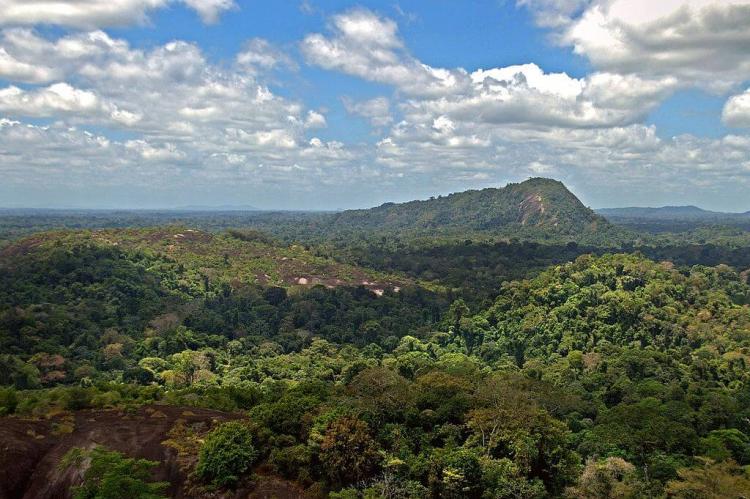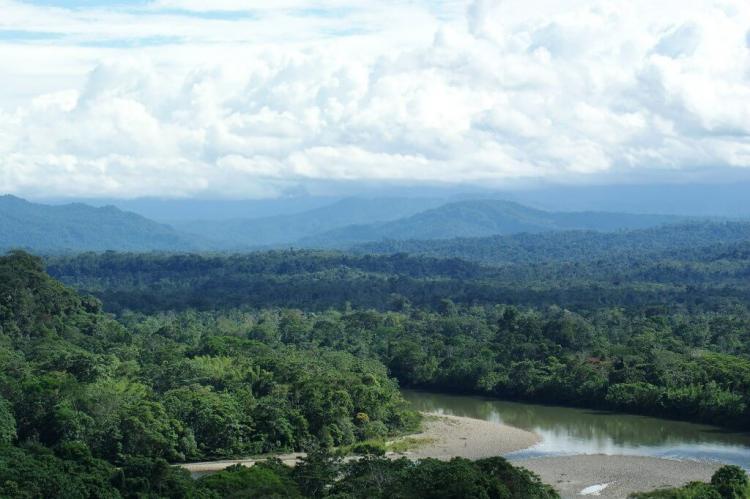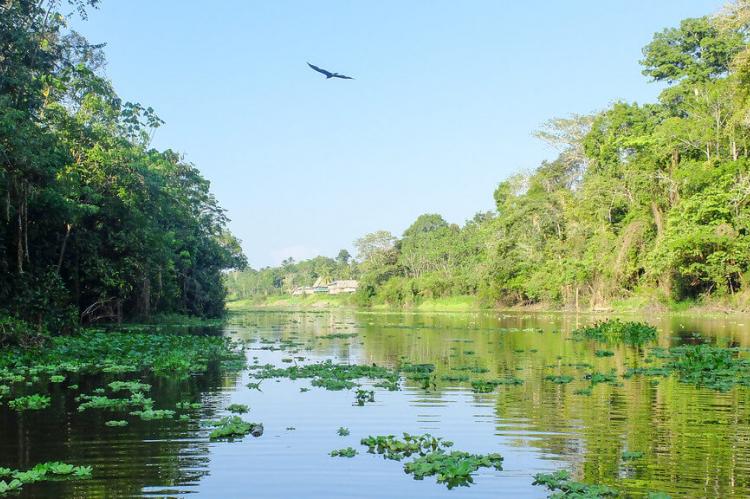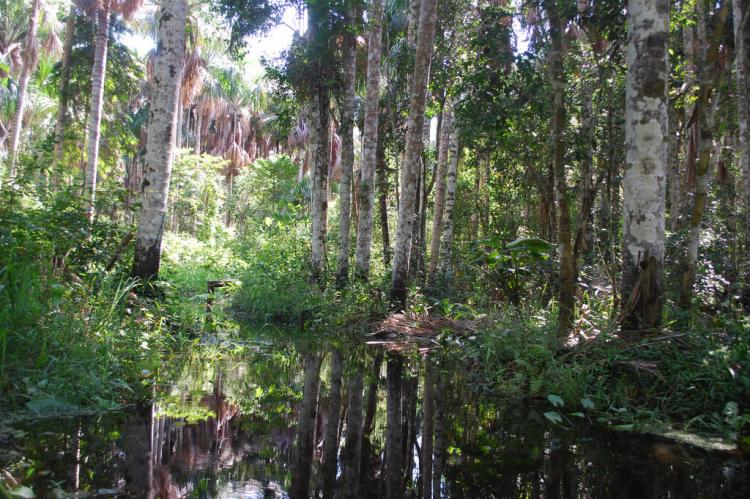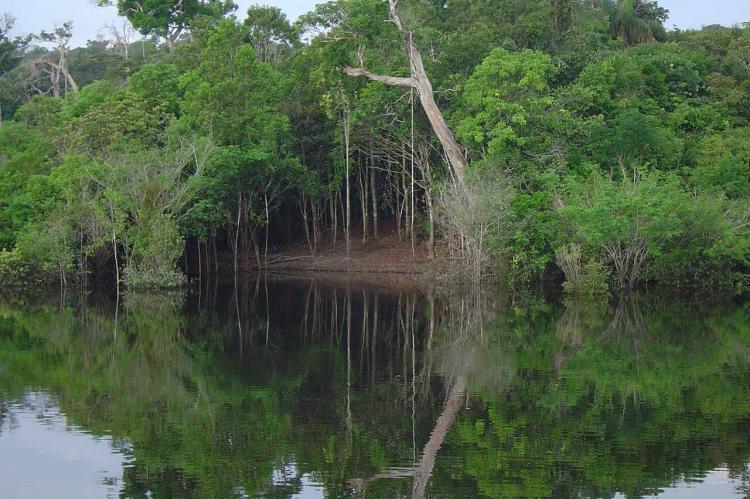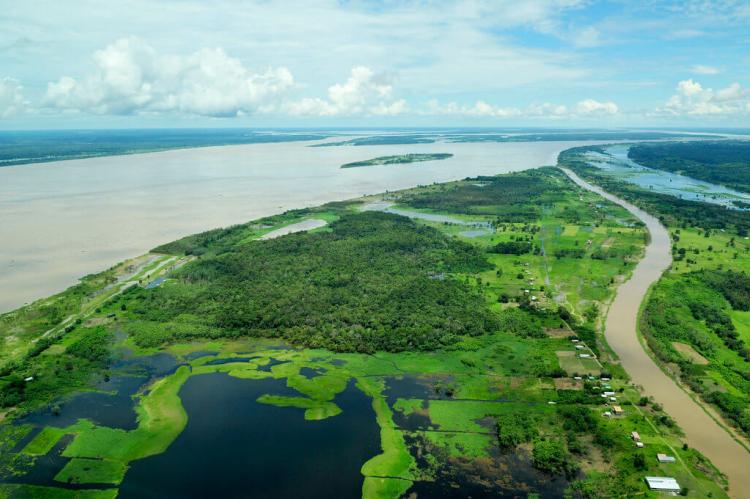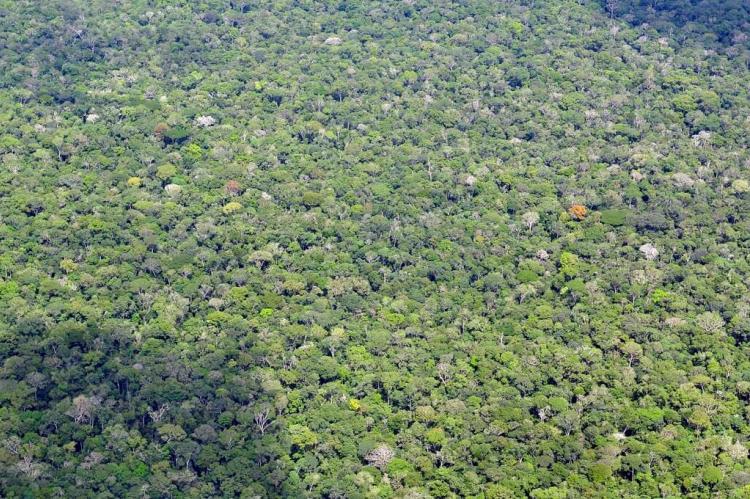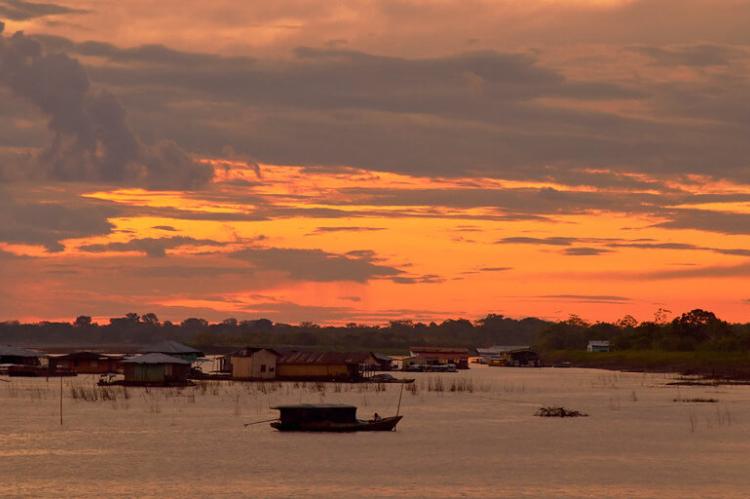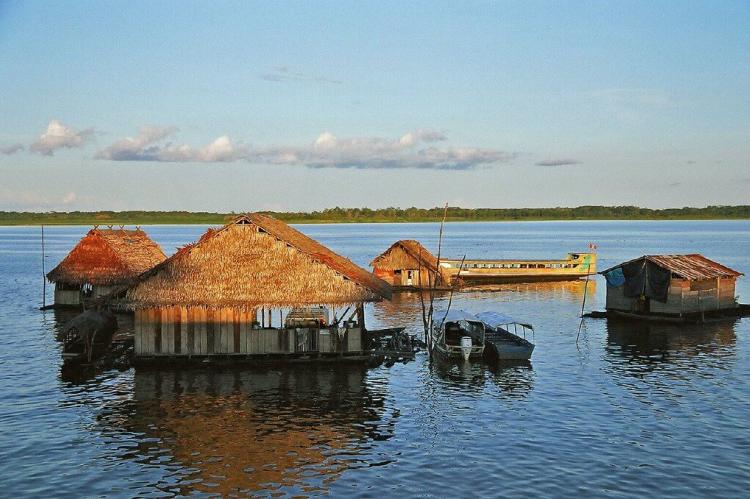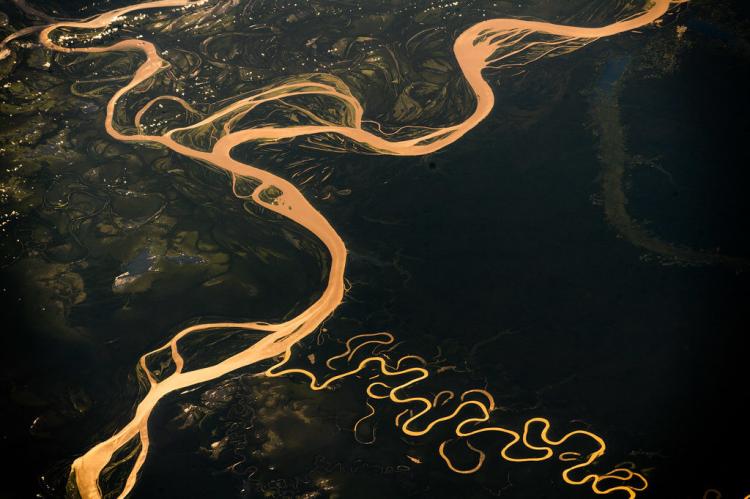Amazônia: Guardian of Biodiversity and Lifeline of the Earth
Amazônia, or "The Amazon," is a vast and biodiverse region in South America, spanning nine countries. It includes the Amazon rainforest, biome, basin, and river. As the "lungs of the Earth," Amazônia plays a crucial role in regulating the planet's climate and producing oxygen.
Amazônia: Guardian of Biodiversity and Lifeline of the Earth
Amazônia, or "The Amazon," is a vast and awe-inspiring region of South America. Often called the "lungs of the Earth," this immense expanse of lush green forest, stretching across nine countries, is home to unparalleled plant and animal life, making it one of the Earth's most biodiverse ecosystems. Comprising the Amazon rainforest, the Amazon biome, the Amazon basin, and the Amazon River, Amazônia plays a crucial role in regulating the planet's climate and producing oxygen.
Amazon Rainforest: Verdant Microcosm of Life
The Amazon rainforest, located in the Amazon basin, is a tropical rainforest covering most of Amazônia. It is characterized by dense vegetation, high humidity, and abundant rainfall, creating a unique microclimate supporting an extraordinary life array. The rainforest's lush canopy, composed of towering trees, provides a haven for countless species, from insects and birds to monkeys and jaguars.
This tropical rainforest is a moist broadleaf forest in the Amazon biome, covering an area of approximately 5.5 million square kilometers (2.1 million square miles). It is situated in northern South America and is part of a biogeographical region that occupies the Amazon basin, a drainage basin of the Amazon River and its tributaries. Nine countries have some parts of the Amazon rainforest within their borders.
Most of the forest is contained within Brazil, with 60% of the rainforest, followed by Peru with 13%, Colombia with 10%, and minor amounts in Venezuela, Ecuador, Bolivia, Guyana, Suriname, and French Guiana. Comprising about 40% of Brazil's total area, the Guiana Highlands bounds the Amazon region to the north, the Andes Mountains to the west, the Brazilian central plateau to the south, and the Atlantic Ocean to the east.
The Amazon represents over half of the planet's remaining rainforests. It comprises the world's largest and most biodiverse tract of tropical rainforest, with an estimated 390 billion individual trees divided into 16,000 species. Wet tropical forests are the most species-rich biome, and tropical forests in the Americas are consistently more species-rich than the moist forests in Africa and Asia.
As the largest tract of tropical rainforest in the Americas, the Amazonian rainforests have unparalleled biodiversity. One in ten known species in the world lives in the Amazon rainforest. This constitutes the world's most extensive collection of living plants and animal species.
Amazon Biome: Beyond the Rainforest
The Amazon biome extends beyond the Amazon rainforest, encompassing a broader range of ecosystems, including savannas, grasslands, and flooded forests. It excludes areas of the Andes to the west and the Cerrado (tropical savanna) to the south. However, it includes lands to the northeast extending to the Atlantic Ocean with vegetation similar to the Amazon basin.
This diverse landscape supports a wide variety of plant and animal species adapted to their specific habitats. There are 53 significant ecosystems and over 600 land and freshwater habitat types. Of the ecosystems, 34 are forest areas covering 78% of the biome, six are Andean covering 1.5%, five are floodplains covering 5.83%, five are savanna covering 12.75%, and two are tropical steppes covering 1.89%.
The Brazilian Amazon holds 30 of the 53 ecosystems, of which 19 are forests occupying 77.5% of the area. The borders of the biome contain ecotones where it blends into other biomes, such as the Cerrado. Within and across the ecosystems of the biome, there is enormous biological diversity.
The biome faces threats from deforestation, habitat fragmentation, and climate change, necessitating comprehensive conservation strategies to protect its ecological integrity.
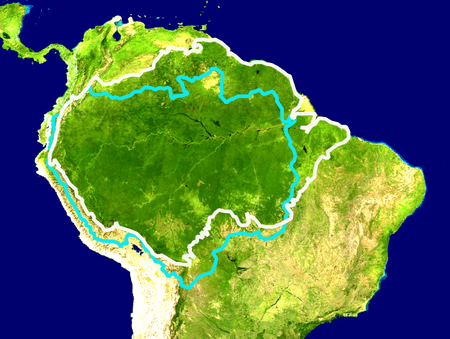
Outline map depicting the extent of the Amazon biome (white outline) and Amazon basin (blue outline).
Amazon Basin: Cradle of Life
The Amazon basin, the cradle of the Amazon rainforest, is the part of South America drained by the Amazon River and its tributaries. Numerous tributaries feed into the Amazon River within the basin, forming an intricate network of waterways.
This vast, low-lying area encompasses approximately 6.9 million square kilometers (2.7 million square miles), covering about 35 percent of the South American continent. The basin includes the greater part of Brazil and Peru, significant parts of Colombia, Ecuador and Bolivia, and a small area of Venezuela.
This immense depression, shaped over millions of years by the erosion of the Andes Mountains, serves as a giant catchment area for rainfall, fueling the rainforest's ecosystem. The basin's waterways, including the mighty Amazon River, transport nutrients and sediments, sustaining the rainforest's diverse life forms. The basin hosts an incredible diversity of aquatic life, including numerous fish species, dolphins, and other marine organisms.
The basin is also home to various indigenous communities that have adapted to the unique challenges and opportunities the riverine environment presents.
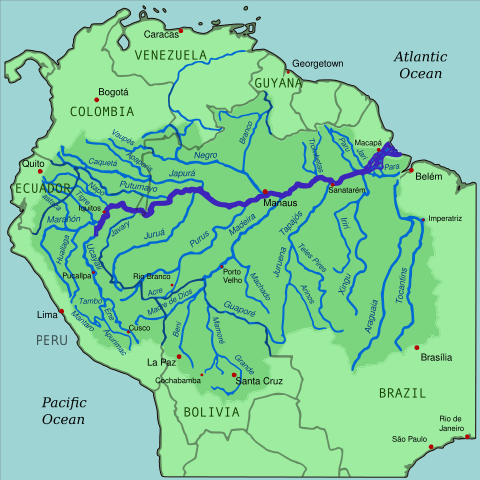
Map depicting the Amazon River drainage basin with the Amazon River highlighted.
Amazon River: Lifeline of Amazônia
The Amazon River, the world's largest river by discharge volume, is the lifeline of Amazônia. This mighty waterway, stretching over 6,400 kilometers (4,000 miles), as measured from the headwaters of the Ucayali-Apurímac river system of Peru, snakes through the rainforest, carrying an estimated 200,000 cubic meters of water per second.
The Amazon River and its tributaries flow through the countries of Peru, Bolivia, Venezuela, Colombia, Ecuador and Brazil before emptying into the Atlantic Ocean. More significant than the following seven largest independent rivers combined, the Amazon River represents 20% of the global riverine discharge to the ocean.
The river plays a crucial role in the region's ecosystem, providing habitat for countless aquatic species, transporting nutrients for plant growth, and influencing the region's climate. The river and its tributaries are characterized by extensive forested areas that flood every rainy season. Every year, the river rises more than 9 meters (30 feet), flooding the surrounding forests, known as várzea ("flooded forests"). The Amazon's flooded forests are the most extensive example of this habitat type worldwide.
The river is a crucial transportation route for trade and local communities, fostering regional economic activities. However, it faces environmental challenges such as pollution, deforestation, and dam construction, which can impact its ecology and the livelihoods of those dependent on it.
Conservation Challenges and Efforts
Despite its immense ecological importance, Amazônia faces many threats, including deforestation, climate change, pollution, and infrastructure development. These threats have far-reaching consequences, disrupting ecosystems, endangering species, and contributing to climate change.
Numerous efforts are underway to conserve Amazônia and its biodiversity. These efforts include:
- Establishing and expanding protected areas: Designating areas as national parks, indigenous territories, and other protected areas helps to safeguard Amazônia's forests and wildlife.
- Promoting sustainable development practices: Encouraging sustainable forestry, agriculture, and ecotourism practices can reduce deforestation and provide alternative livelihoods for local communities.
- Supporting indigenous rights: Recognizing and upholding the rights of indigenous communities is crucial for protecting Amazônia, as they have a deep understanding of and connection to the rainforest.
- International collaboration: Addressing the threats to Amazônia requires international cooperation and support, such as through financial assistance, technology transfer, and capacity building.
Conclusion
In conclusion, Amazônia, with its Amazon rainforest, biome, basin, and river system, stands as a guardian of biodiversity and a lifeline for Earth. As we navigate the conservation challenges, recognizing the intrinsic value of this vast region is essential for preserving its ecological integrity and securing a sustainable future for Amazônia and the planet.
